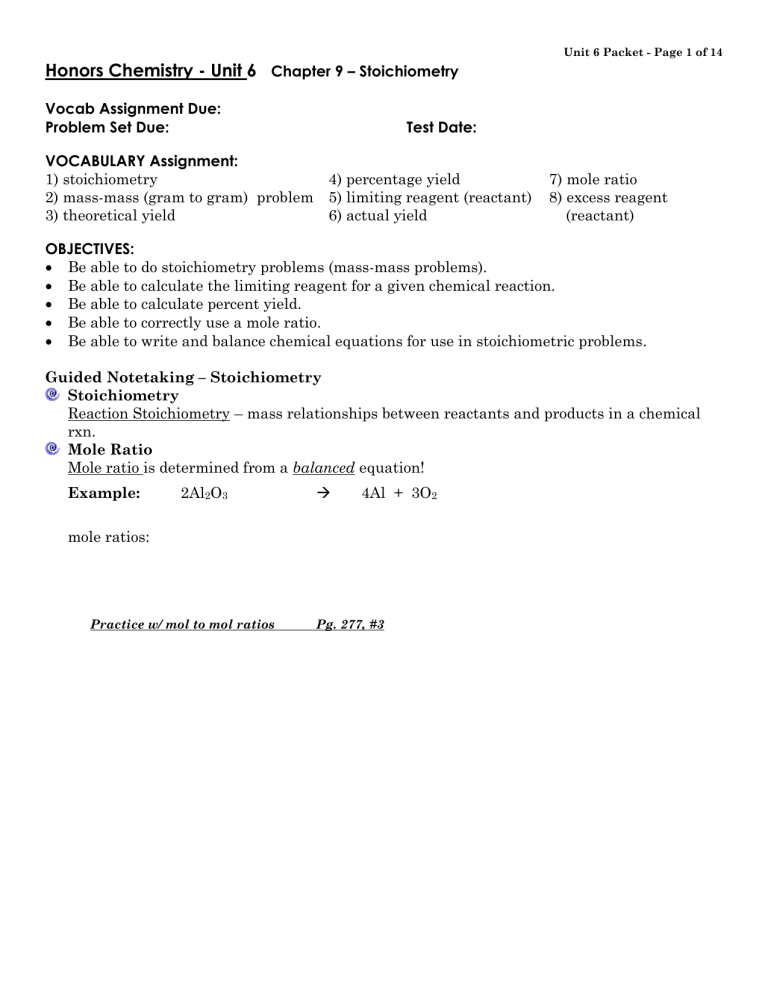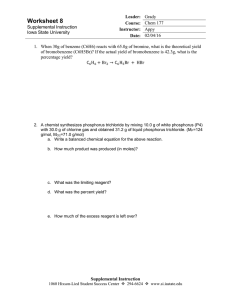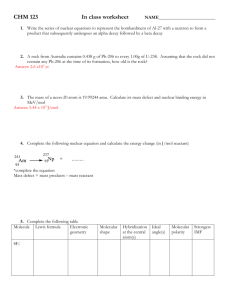Stoichiometry

Unit 6 Packet - Page 1 of 14
Honors Chemistry - Unit 6
Chapter 9 – Stoichiometry
Vocab Assignment Due:
Problem Set Due: Test Date:
VOCABULARY Assignment:
1) stoichiometry 4) percentage yield 7) mole ratio
2) mass-mass (gram to gram) problem 5) limiting reagent (reactant) 8) excess reagent
3) theoretical yield 6) actual yield (reactant)
OBJECTIVES:
Be able to do stoichiometry problems (mass-mass problems).
Be able to calculate the limiting reagent for a given chemical reaction.
Be able to calculate percent yield.
Be able to correctly use a mole ratio.
Be able to write and balance chemical equations for use in stoichiometric problems.
Guided Notetaking – Stoichiometry
Stoichiometry
Reaction Stoichiometry – mass relationships between reactants and products in a chemical rxn.
Mole Ratio
Mole ratio is determined from a balanced equation!
Example: 2Al
2
O
3
4Al + 3O
2 mole ratios:
Practice w/ mol to mol ratios Pg. 277, #3
Unit 6 Packet - Page 2 of 14
Reaction Stoichiometry Problems - “Given” and an “Unknown”
**Type 1: mol to mol problems
Example: Using the previous rxn, how many mol of Al can be produced from 13 mol of aluminum oxide?
Practice w/ mol to mol problems - Pg. 296 - In-class Problems 10a, 11a
** Type 2: mol to g problems
Unit 6 Packet - Page 3 of 14
Example: Using the same rxn, how many g of O
2
can be produced from 13 mol Al
2
O
3
?
Example: Using the same rxn, how many g of Al will be produced at the same time as 3 mol
O
2
?
You Try - Textbook, p. 287 2a, b
**Type 3: g to mol problems
Unit 6 Packet - Page 4 of 14
Example: Using the same rxn, how many mol of Al can be produced from 25g Al
2
O
3
?
Example: Using the same rxn, how many mol of Al
2
O
3
will be needed to produce 25 g Al?
You try: How many moles of salt can be formed from 12.0g of sodium reacting with Cl
2
?
**Type 4: g to g problems (aka mass to mass problems)
Unit 6 Packet - Page 5 of 14
Example: Using the same rxn, how many g of Al can be produced from 25g Al
2
O
3
?
Example: Using the same rxn, how many g of Al
2
O
3
will be needed to produce 25 g Al?
You Try: Textbook, p. 287, #4
Unit 6 Packet - Page 6 of 14
Limiting Reagent (Reactant) – (LR)
Controls the amt. of product formed
Completely consumed in the rxn.
“runs out” first
Example:
People on plane 300 people; 250 seats
**Seats are the limiting factor**
Limiting Reagent Problems
Do mass – mass (g to g) calc. for all reactants.
Whichever reactant produces the least is the Limiting Reagent (LR)
Example: If 5.0g of hydrogen reacts w/ 5.0g of oxygen to make water, which reactant is the
LR? How much H
2
O is produced?
Practice pg. 297 #26 a,c;
Excess Reactant (ER)
To find the amount of excess reactant leftover after a rxn:
Do two mass-mass (g to g) problems to find LR
Use LR to calculate excess reactant used.
Subtract excess reactant used from original amt. of excess reactant = leftover excess reactant
ER Example:
If 15.0g of salt (NaCl) reacts with 20.0g silver nitrate: a) How much AgCl is formed? b) What is the limiting reagent? c) How much of the excess reagent is left over?
Practice - p. 297, 26b
If 13.0g of KOH reacts with 17.0g of Al(NO
3
)
3
: a) How much KNO3 is produced? b) What is the limiting reagent? c) How much of the excess reactant is left over?
Percent Yield
% yield = actual yield theoretical yield theoretical yield:
maximum amt. of product
from mass-mass (g to g) problem
X 100% actual yield:
actual amt. of product
from lab result; or given in a problem
Example:
CO + 2H
2
CH
3
OH
If 75.0g of CO reacts to produce 68.4g of CH
3
OH, what is the % yield?
Practice pg. 297 #26 a,c; pg. 297 #28, 31
Unit 6 Packet - Page 7 of 14
Stoichiometry - Mole to Mole Problems
Unit 6 Packet - Page 8 of 14
Stoichiometry – Mass to Mass Problems
Unit 6 Packet - Page 9 of 14
Unit 6 Packet - Page 10 of 14
Stoichiometry Worksheet #1
Perform the following calculations. Be sure to use proper units!
Answer the following g mol and/or mol g conversion problems.
1.
How many g in 7.00 mol of N
2
? _______
2.
How many g in 0.455 mol of NaCl? _______
3.
How many mol in 23.0 g of CaCO
3
? _______
Answer questions 4-9 given the following equation.
2AgNO
3(aq)
+ Na
2
CO
3(aq)
Ag
2
CO
3(s)
+ 2NaNO
3(aq)
?
4.
What is the ratio of mol of AgNO
3 to mol of Ag
2
CO
3
? ________
5.
What is the ratio of mol of Na
2
CO
3
to mol of NaNO
3
? ________
6.
What is the ratio of mol of AgNO
3 to mol of Na
2
CO
3
? _______
7.
How many mol of Na
2
CO
3
are required to produce 2.00 Mol of Ag
2
CO
3
? _______
8.
How many mol of Ag
2
CO
3
are produced from 3.00 mol of AgNO
3
? _______
9.
How many g of Na
2
CO
3 are required to produce 1 mol of Ag
2
CO
3
? _______
Answer questions 10-13 given the following equation.
3BaCl
2(aq)
+ 2H
3
PO
4(aq)
Ba
3
(PO
4
)
2(s)
+ 6HCl
(aq)
10.
What is the mol ratio between BaCl
2 and Ba
3
(PO
4
)
2
? _______
11.
Given 10.0 g of BaCl
2
, how many g of Ba
3
(PO
4
)
2
will be produced? _______
Remember: g mol mol g
12.
Given 10.0 g of BaCl
2
, how any g of HCl will be produced? ________
13. How many g of BaCl
2
is required to produce 20.0g of HCl? _______
Unit 6 Packet - Page 11 of 14
Stoichiometry Worksheet #2
Perform the following calculations. Be sure to use proper units!
Write the equation for the reaction in chemical symbols when necessary, then answer the following mass-mass problems.
1.
(a) Write the equation for the synthesis of carbonic acid from water and carbon dioxide.
(b) Given 15.0 g of water and an excess of carbon dioxide, how much carbonic acid would be produced?
2.(a) Write the decomposition reaction for sodium chloride.
(b) How many g of sodium chloride will produce 19.0 g of sodium?
(c) How many g of chlorine will be produced from the conditions in (b)?
3. Given this equation: Al(NO
3
)
3(aq)
+ 3NaOH
(aq)
Al(OH)
3(s
) + 3NaNO
3(aq)
(a) If 15.0 g of aluminum nitrate reacts completely with sodium hydroxide, what would be the resulting mass of aluminum hydroxide?
(b) Would be the resulting mass of sodium nitrate under the same conditions?
(c) How many g of sodium hydroxide would be needed to form 13.0 g of aluminum hydroxide?
Unit 6 Packet - Page 12 of 14
STOICHIOMETRY PRACTICE – Work problems on a separate piece of paper.
Remember: You must have correct, balanced equations to work these problems!!
1.
In the synthesis reaction of iron (II) with sulfur, what mass of iron is needed to react completely with 32.0 g of sulfur?
2.
Given: Zn + 2 HBr ZnBr
2
+ H
2
; What mass of zinc bromide can be produced from 25.0 g of hydrobromic acid ?
3.
Silver bromide can be precipitated by the reaction of silver nitrate with sodium bromide.
What weight of precipitate can be produced starting with 34.3 g of sodium bromide?
4.
Hydrochloric acid is added to 50.0 g of iron (II) sulfide. What mass of hydrogen sulfide is produced?
5.
Given the Haber process: N
2
+ 3 H
2
2NH
3
If 3.41 g of hydrogen reacts with 2.2 g of nitrogen – what is the limiting reagent? How much ammonia is produced?
6.
When 25 g of calcium reacts with 25 g of chlorine, how much calcium chloride is produced?
7. In lab, you start with 128 g of sulfur dioxide to produce 150 g of sulfurous acid. How much sulfurous acid should be produced and what is your percent yield?
SO
2
+ H
2
O H
2
SO
3
Review Sheet Unit 6 - Stoichiometry
1.
Write a balanced equation for the reaction of aluminum nitrate with sodium hydroxide. What type of rxn is this?
2. How many g of sodium hydroxide would be needed to from 13.0 g of Al(OH)
3
?
3. How many mol of aluminum hydroxide would be formed from 15.0 g of Al(NO
3
)
3
?
4.
For the decomposition of mercury (II) oxide how many g of O
2
are formed from 10 mol of HgO?
5.
Given: C
7
H
6
O
3
+ CH
3
OH C
8
H
8
O
3
+ H
2
O A chemist starts with 1.75 g of C produces 1.42 g of C
8
H
8
O
3
– what is her percent yield?
7
H
6
O
3
and
6.
Suppose a solution containing 3.50 g of sodium phosphate is mixed with a solution containing
6.40 g of barium nitrate. How many grams of barium phosphate can be formed?
Answers:
1. Al(NO
3
)
3
+ 3 NaOH Al(OH)
3
+ 3 NaNO
3
Double displacement
2. 20.0 g NaOH
3. 0.0704 mol Al(OH)
3
4. 160 g O
2
5. 73.6%
6. 4.92 g
Unit 5 Problem Set Name:
Unit 6 Packet - Page 13 of 14
First and last name please!
Pd:___
You must show work for credit – put final answer on the blank provided include units!
Review Questions:
1.
Write balanced equations for the following reactions:
A.
Potassium metal is added to water.
B.
A solution of lead (II) nitrate is added to a solution of iron (III) sulfate
C.
Fluorine gas is bubbled into a solution of potassium iodide.
D.
C
3
H
8 is burned in oxygen
2.
What is the molarity of 45 g of nickel (II) acetate dissolved in enough water to make 250 ml of solution?
Current Unit Material
3.
Suppose a solution containing 3.50 g of sodium phosphate is mixed with a solution containing
6.40 g of barium nitrate. How many grams of barium phosphate can be produced?
Balanced Equation:
Grams of barium phosphate:
Unit 6 Packet - Page 14 of 14
4.
Octane, C
8
H
18,
is a component of gasoline.
A.
Write the balanced equation for the complete combustion of octane.
B.
How many grams of O
2
are needed to burn 15.00 g of octane?
C.
Octane has a density of 0.692 g/ml at 20 0 C. How many g of O
2 of octane?
are required to burn 1.50 L
5.
One of the steps in the commercial process for converting ammonia to nitric acid involves the conversion of NH
3
to NO:
4 NH
3
+ 5 O
2
4 NO + 6 H
2
O
A.
How many grams of NO form when 3.50 g of NH
3
reacts with 2.85 g of O
2
?
B.
Which reactant is the limiting reactant and which is the excess reactant?
Limiting reactand :
Excess reactant:
C.
How much of the excess reactant remains after the limiting reactant is completely consumed?




